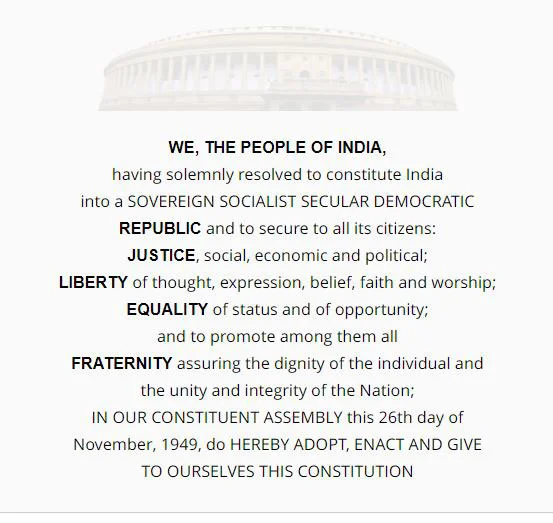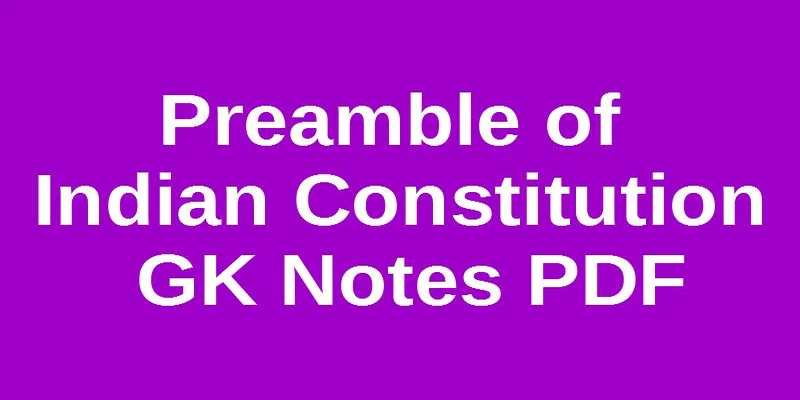The Preamble of Indian Constitution Notes
The preamble is one of the salient features of the Indian Constitution. Although the concept of the preamble was not part of the Indian Constitution itself. India has borrowed this feature from America. The sources of the Constitution and the legal and moral basis of the Constitution are identified through the preamble. The purpose of the preamble is to explain the purpose and principles of the constitution as the basic law of the country.

The Preamble of the Indian Constitution Important Points
The Preamble to the Indian Constitution is a succinct and powerful declaration that encapsulates the Constitution’s foundational concepts and purposes. The preamble describes India as a sovereign, socialist, secular, democratic, republic.
- The term ‘Sovereign‘ is enshrined in the Indian Constitution to mean that India is capable of gaining allegiance from all individuals and institutions within the territory and also India’s relations with other foreign countries are independent. The Government of India can independently formulate and implement its foreign policy.
- The word ‘Socialism‘ in the constitution means to make India a ‘social welfare country‘.
- The word ‘Secular‘ in the constitution means that India is not biased towards any particular religion. The state of India will maintain neutrality in matters of religion.
- The word ‘Democracy‘ in the constitution means a government run by an elected representative on the basis of adult suffrage and such a government will be accountable to the people. Besides, political democracy has been established through the establishment of the rule of law and an independent judiciary system.
- The word ‘Republic‘ in the constitution means that there is no place for a king or monarchy in India. The real controlling power is vested in the hands of the people here. In India, the head of the country is the president, who is indirectly elected for a fixed term. That is, the post of the head of the country is electoral. Besides, irrespective of men and women, caste, and religion all should have equal opportunity to participate in the election.
In the preamble, the word ‘we are the people of India‘ means that the Indian people are liable to the Indian constitution and can have sovereign power. There is a moral basis to abide by the Constitution. Because the ultimate government has been adopted by the people in the Indian Constitution.
In the first session of the Constituent Assembly, on 13th December 1946, Pandit Nehru raised a proposal containing the hopes, aspirations and ideals of the people. It mentions the purpose and philosophy of the Constitution. Proposals are approved in that year on 22nd December. In fact, the preamble of the Constitution has been made based on this preface.
The preamble is the Preface of the Constitution. In the same way that the preface of a book is considered the ‘key’ or ‘soul’ of the book, the preamble is also considered the ‘soul or key‘ of the Constitution.
In the original preamble of the constitution, India was referred to as ‘sovereign‘, ‘democratic‘ and ‘republic‘. But later, through the 42nd amendment of the constitution in 1976, the words “socialism” and “secular” were added.
At present, India is mentioned in the Preamble in this way
- Sovereign
- Socialist
- Secular
- Democratic
- Republic.
The preamble was amended only once till now as I said through the 42nd amendment of the constitution in 1976.
The preamble calls for the establishment of social, economic and political justice for the citizens. Lamentation of untouchability, special privileges for the underprivileged, economic equality, equal rights to all, etc. are mentioned [Justice].
Freedom: The preamble recognizes freedom of thought, expression, belief, religion and worship for all citizens. The right to freedom is mentioned under Articles 19 to 22. Articles 25 to 28 recognizes the right to religious freedom.
Equality: The principle of equality is enshrined in Articles 14 to 18 of the Constitution.
Berubari Case (1960) – In this case, the Supreme Court declared that “The preamble is not part of the constitution.”
Keshbananda Bharati case (1973) – In this case, the Supreme Court declared that “the preamble is a core part of the constitution.”
LIC of India (Case (1975) – In this case, the Supreme Court reiterated that “the preamble is an integral part of the constitution“.
Creating a perception of Brotherhood – At the end of the proposal, it was said to create brotherhood among all citizens for the sake of individual dignity and national unity.
The word ‘solidarity’ was added through the 42nd Amendment to the Constitution (1976).
K.V Rao in the preface to his book ‘Parliamentary Democracy in India‘ has stated the word ‘People of India‘.
The preamble has been included at the beginning of the Constitution for three main reasons.
- Indications of source, legal basis and moral basis are referred to in the preamble of the constitution.
- The preamble mentions the objectives, policies and date of the constitution.
- Proposals help to explain vague words or sentences in the working part of the Constitution.
Various statements regarding the Preamble of COI:
Thakurdas Vargab called preamble of the Indian constitution as the ‘soul of the constitution‘.
Ernest Barker called India’s preamble as “Key of the constitution“.
K M Munshi called India’s preamble as the horoscope political life.
Read + PDF: All 448 Articles of the Indian Constitution
Read + PDF: 22 Parts of the Indian Constitution
The Preamble of Indian Constitution – GK Notes Download
FAQs from the Preamble of COI:
What is the purpose of the Preamble?
[D] To state the guiding principles and objectives of the Constitution
Which of the following is NOT mentioned in the Preamble?
[D] Charity
The Preamble was adopted on _______
[C] November 26, 1949
